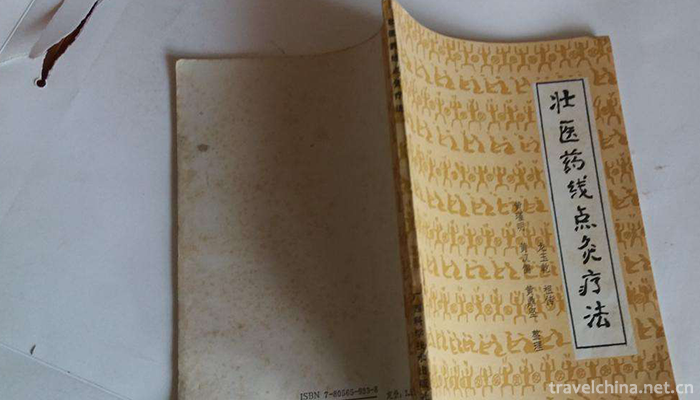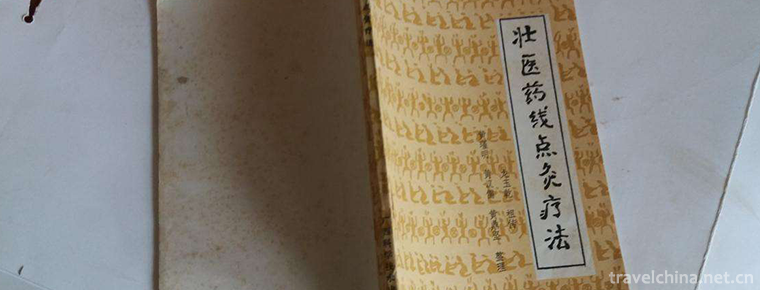Zhuang medicine thread moxibustion therapy
Zhuang medicine thread moxibustion therapy
Declaration area or unit: Guangxi College of Traditional Chinese Medicine
Zhuang medicine is the traditional medicine of the Zhuang people. It is a national traditional medicine based on the ancient Luoyue culture and Lingnan culture, with Yin and Yang as its foundation, Qiaowu (brain) as its main god, man, earth and three Qi synchronization, viscera, bones, flesh and blood as its body, airway, Valley and waterway as its "three roads" and "two roads" of Dragon Road and Fire Road as its use.
Drug thread moxibustion is one of the external therapies of Zhuang medicine. The medicinal thread used in Zhuang medicine is made of ramie, with diameters ranging from 0.25 mm to 0.7 mm and 1 mm. It is dried after soaking in medicinal water. When used, the medicine thread is ignited and the patients'body surface acupoints are ignited so as to dredge the Dragon Road and fire road. It has the functions of dispelling wind and removing arthralgia, relieving pain and itching, activating blood circulation and removing blood stasis, dissipating swelling and dispersing nodules. This treatment, ramie thread and soaked medicinal liquid, are local materials, herbal medicinal liquid prescription composition, according to the theory of Zhuang medicine prescription. The selected acupoints are plum blossom, lotus blossom, Changzi (both resembling their image) and experience points, and can also be used in acupuncture and moxibustion of traditional Chinese medicine.
There are more than 16 million people of Zhuang nationality in China, mainly distributed in Guangxi Zhuang Autonomous Region and Wenshan Zhuang Autonomous Prefecture of Yunnan Province. The application of Zhuang medicine mainly focuses on the Zhuang people, and the surrounding Miao, Yao and Dong nationalities also exchange and cross-use. The thread-point moxibustion therapy of Zhuang medicine, because of its convenient application and good curative effect, has been popularized to the whole country as a suitable technology in rural areas.


-
2.Ancient Villages in Southern AnhuiXidi and Hongcun
Ancient villages in southern Anhui refer to some traditional villages distributed in Anhui and Jiangxi provinces of China and south of the Yangtze River.
Time 2018-12-08 -
3.Fanggan Ecological Scenic Area
Fanggan Eco-tourism Area is located in Luye Township in the north of Laiwu City. It is bordered by Jinan in the north, Zibo in the East and Taian in the west. National Highway 09 is very convenient fo
Time 2019-01-12 -
4.Hainan Tropical Wildlife Park and Botanical Garden
Hainan Tropical Wildlife and Botanical Garden is a national AAAA-level tourist attraction with the theme of popular science exposition, conservation and reproduction, sightseeing, leisure and vacation
Time 2019-01-13 -
5.Eight polar boxing
Bajiquan is a kind of boxing in Chinese Wushu. The word "eight poles" of this boxing method originated from the concept of Palaeogeography and originated from the Han Dynasty
Time 2019-04-02 -
6.Baoding old tune
Baoding old tune, also known as old tune bangzi, is one of the traditional operas with a long history in Hebei Province and a national intangible cultural heritage. At first, it was a popular Hexi tun
Time 2019-05-11 -
7.Hainan opera Qiongju Opera
In June 2008, Qiongju Opera declared by Hainan Qiongju Theatre and Haikou City was listed in the second batch of national intangible cultural heritage list with the approval of the State Council.
Time 2019-06-11 -
8.Meat rustles
"Meat Lianliang" refers to the native minority local dance variety in Lichuan City, Hubei Province, which takes the unique body performance as the main form. It is popular in the city's Duti
Time 2019-06-11 -
9.Firing Techniques of Wuzhou Kiln Ceramics
The traditional firing technique of Wuzhou kiln is a local traditional handicraft technique in Zhejiang Province. Wuzhou kiln is located in Tiedian Village, Langya Township, Jinhua City. Jinhua was na
Time 2019-06-30 -
10.Recitative
Recitation is a local traditional music form in Changzhou City, Jiangsu Province, which has a high reputation at home and abroad. The art of reciting belongs to "minority culture", which is
Time 2019-07-13 -
11.Zhuxian Town Wood Print New Year Picture
Zhuxianzhen Wood Engraving New Year Picture is one of the ancient Chinese traditional crafts. As the originator of Chinese woodcut New Year pictures, is mainly distributed in Kaifeng, Zhuxian Town and
Time 2019-08-10 -
12.Guangyuan primary industry
In 2018, the annual grain sown area in Guangyuan City was 311300 hectares, down 0.5% from the previous year. The total grain output was 1.5641 million tons, down 0.4%. Among them, the grain output in spring decreased by 0.7% to 384900 tons, and that
Time 2020-12-15